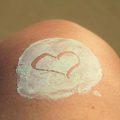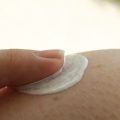The common symptoms of scabies (extreme itching, sores and rashes) can also be symptoms of other skin conditions. This is why doctors often perform a series of tests to get the right diagnosis.
Diagnosing Scabies
To treat scabies, doctors, particularly dermatologists conduct diagnosis through visual exam. They check the patient’s skin condition from head to toe. To check for scabies, they scrape the skin for a sample (definitely painless) by putting a drop of saline or oil on the affected area, put the skin on a glass slide and inspect the sample using a microscope. If they see mites (and/or their egg), then they’re certain it’s a scabies infection.
Dermatologists may also use the felt-tip marker test and draw across the rash (using the washable felt-tip marker) and wipe it off using alcohol. This may help doctors identify the burrows made by mites, as the ink penetrates the skin.
In some cases, mites, eggs or their feces may be hard to find under the microscope, which is why most doctors still usually recommend treatment if he suspects his patient is experiencing a scabies infection.
Scabies Treatment
To treat scabies, doctors prescribe medications to get rid of the infestation and its symptoms, usually in the form of topical medications (creams, lotions and ointments). Skin doctors will provide instructions on how to use and apply the medications. Topical treatments are usually applied at night, when the mites are most active. One may need to treat his entire body, from neck down, especially with visible symptoms. The topical medicine can then be washed off the morning after.
Common topical medications to treat scabies usually include:
– 25% benzyl benzoate lotion
– 10% sulfur ointment
– 10% crotamiton cream
– 5% permethrin cream
– 1 % lindane lotion
In some cases, doctors may also prescribe other medications to quickly relieve vexing symptoms, especially itching. These medications are usually in the form of:
– Antihistamines – Benadryl or Pramoxine Lotion to relieve itching
– Antibiotics – to exterminate infections caused by constant scratching
– Steroid creams – to relive the skin from rashes and swelling caused by itching
For severe and widespread scabies, doctors may prescribe oral medications such as ivermectin, especially for patients who:
– Don’t see any positive changes in symptoms after the initial topical treatments
– Have visible crusted scabies
– Have scabies that almost covers their entire body
Symptoms may seem getting worse in the first week of initial treatment. This is because the mites are battling the treatment. However, after 5 or 7 days, one will notice significantly less itching. Also, there should be complete healing after a month of treatment. Those parts of skin that has not healed after four weeks of treatment may still be infested with the mites.
Thus, it is important to visit your doctor again if the symptoms persist after 4 weeks of treatment.
Though scabies infection is can only be treated using prescription medication provided by your doctor, there are certain things one can do to home to keep them from acquiring the infection again, and keep everyone in their household safe from mite-causing scabies. This includes washing all the clothes, bedding’s, towels, etc. with warm water to kill the mites.
Items that can’t be washed must be stored in a bag and store them away for a week to suffocate the mites. Carpets, furniture, car interiors, and bedding’s must be vacuumed thoroughly, and the vacuum cleaner’s bag must be thrown and replaced after cleaning.






 I love to write medical education books. My books are written for everyone in an easy to read and understandable style.
I love to write medical education books. My books are written for everyone in an easy to read and understandable style.